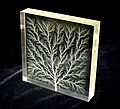Fractal: Difference between revisions
Duckmackay (talk | contribs) →External links: added link to flash fractal |
|||
| Line 151: | Line 151: | ||
*[http://www.geom.uiuc.edu/~math5337/ds/ One Dimensional Dynamical Systems]. From UIUC a brief introduction |
*[http://www.geom.uiuc.edu/~math5337/ds/ One Dimensional Dynamical Systems]. From UIUC a brief introduction |
||
*[http://geometricarts.googlepages.com/rotationalfractals Rotational Fractal] — Creation of simple fractals using arraying technique |
*[http://geometricarts.googlepages.com/rotationalfractals Rotational Fractal] — Creation of simple fractals using arraying technique |
||
*[http://http://www.spacesbetween.ca/Studiofolder/HOME%20FRACTAL%20PAGE.htm Spinning Fractal - Flash movie]. |
|||
===Multiplatform generator programs=== |
===Multiplatform generator programs=== |
||
*[http://xaos.sourceforge.net/ Xaos] — free fractal real-time browser for Windows, Mac, Linux; supporting zooming and animation in real time, featuring autopilot. GNU GPL licensed. |
*[http://xaos.sourceforge.net/ Xaos] — free fractal real-time browser for Windows, Mac, Linux; supporting zooming and animation in real time, featuring autopilot. GNU GPL licensed. |
||
Revision as of 12:41, 13 March 2007
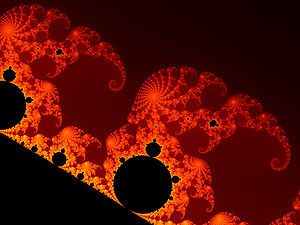
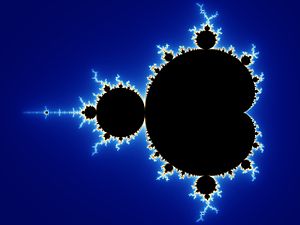
In colloquial usage, a fractal is "a rough or fragmented geometric shape that can be subdivided in parts, each of which is (at least approximately) a reduced-size copy of the whole"[1]. The term was coined by Benoît Mandelbrot in 1975 and was derived from the Latin fractus meaning "broken" or "fractured".
A fractal as a geometric object generally has the following features:
- It has a fine structure at arbitrarily small scales.
- It is too irregular to be easily described in traditional Euclidean geometric language.
- It is self-similar (at least approximately or stochastically).
- It has a Hausdorff dimension that is greater than its topological dimension (although this requirement is not met by space-filling curves such as the Hilbert curve).
- It has a simple and recursive definition.[2]
Because they appear similar at all levels of magnification, fractals are often considered to be infinitely complex (in informal terms). Natural objects that approximate fractals to a degree include clouds, mountain ranges, and lightning bolts. However, not all self-similar objects are fractals—for example, the real line (a straight Euclidean line) is formally self-similar but fails to have other fractal characteristics.
History
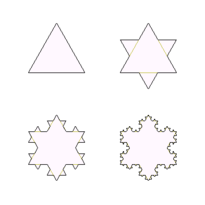
Objects that are now described as fractals were discovered and described centuries ago. Some of the earliest man-made examples can be seen in indigenous African craft work[3]. In 1525, the German artist Albrecht Dürer published The Painter's Manual, which contained a section on "Tile Patterns Formed by Pentagons". Dürer's Pentagon largely resembles the Sierpinski carpet, replacing squares with pentagons.
The mathematics behind fractals began to take shape in the 17th century when philosopher Leibniz considered recursive self-similarity (although he made the mistake of thinking that only the straight line was self-similar in this sense).
It took until 1872 before a function appeared whose graph would today be considered fractal, when Karl Weierstrass gave an example of a function with the nonintuitive property of being everywhere continuous but nowhere differentiable. In 1904, Helge von Koch, dissatisfied with Weierstrass's very abstract and analytic definition, gave a more geometric definition of a similar function, which is now called the Koch snowflake. In 1915, Waclaw Sierpinski constructed his triangle and, one year later, his carpet. Originally these geometric fractals were described as curves rather than the 2D shapes that they are known as in their modern constructions. The idea of self-similar curves was taken further by Paul Pierre Lévy, who, in his 1938 paper Plane or Space Curves and Surfaces Consisting of Parts Similar to the Whole, described a new fractal curve, the Lévy C curve.
Georg Cantor also gave examples of subsets of the real line with unusual properties—these Cantor sets are also now recognized as fractals.
Iterated functions in the complex plane were investigated in the late 19th and early 20th centuries by Henri Poincaré, Felix Klein, Pierre Fatou and Gaston Julia. However, without the aid of modern computer graphics, they lacked the means to visualize the beauty of many of the objects that they had discovered.
In the 1960s, Benoît Mandelbrot started investigating self-similarity in papers such as How Long Is the Coast of Britain? Statistical Self-Similarity and Fractional Dimension, which built on earlier work by Lewis Fry Richardson. Finally, in 1975 Mandelbrot coined the word "fractal" to denote an object whose Hausdorff-Besicovitch dimension is greater than its topological dimension. He illustrated this mathematical definition with striking computer-constructed visualizations. These images captured the popular imagination; many of them were based on recursion, leading to the popular meaning of the term "fractal".
Examples

A relatively simple class of examples is given by the Cantor sets, Sierpinski triangle and carpet, Menger sponge, dragon curve, space-filling curve, and Koch curve. Additional examples of fractals include the Lyapunov fractal and the limit sets of Kleinian groups. Fractals can be deterministic (all the above) or stochastic (that is, non-deterministic). For example, the trajectories of the Brownian motion in the plane have a Hausdorff dimension of 2.
Chaotic dynamical systems are sometimes associated with fractals. Objects in the phase space of a dynamical system can be fractals (see attractor). Objects in the parameter space for a family of systems may be fractal as well. An interesting example is the Mandelbrot set. This set contains whole discs, so it has a Hausdorff dimension equal to its topological dimension of 2—but what is truly surprising is that the boundary of the Mandelbrot set also has a Hausdorff dimension of 2 (while the topological dimension of 1), a result proved by Mitsuhiro Shishikura in 1991. A closely related fractal is the Julia set.
Generating fractals
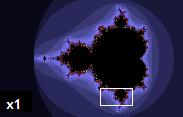
|

|

|
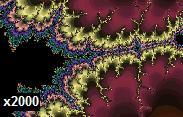 Even 2000 times magnification of the Mandelbrot set uncovers fine detail resembling the full set. Even 2000 times magnification of the Mandelbrot set uncovers fine detail resembling the full set. |
Three common techniques for generating fractals are:
- Escape-time fractals — These are defined by a recurrence relation at each point in a space (such as the complex plane). Examples of this type are the Mandelbrot set, Julia set, the Burning Ship fractal and the Lyapunov fractal.
- Iterated function systems — These have a fixed geometric replacement rule. Cantor set, Sierpinski carpet, Sierpinski gasket, Peano curve, Koch snowflake, Harter-Heighway dragon curve, T-Square, Menger sponge, are some examples of such fractals.
- Random fractals — Generated by stochastic rather than deterministic processes, for example, trajectories of the Brownian motion, Lévy flight, fractal landscapes and the Brownian tree. The latter yields so-called mass- or dendritic fractals, for example, diffusion-limited aggregation or reaction-limited aggregation clusters.
Classification of fractals
Fractals can also be classified according to their self-similarity. There are three types of self-similarity found in fractals:
- Exact self-similarity — This is the strongest type of self-similarity; the fractal appears identical at different scales. Fractals defined by iterated function systems often display exact self-similarity.
- Quasi-self-similarity — This is a loose form of self-similarity; the fractal appears approximately (but not exactly) identical at different scales. Quasi-self-similar fractals contain small copies of the entire fractal in distorted and degenerate forms. Fractals defined by recurrence relations are usually quasi-self-similar but not exactly self-similar.
- Statistical self-similarity — This is the weakest type of self-similarity; the fractal has numerical or statistical measures which are preserved across scales. Most reasonable definitions of "fractal" trivially imply some form of statistical self-similarity. (Fractal dimension itself is a numerical measure which is preserved across scales.) Random fractals are examples of fractals which are statistically self-similar, but neither exactly nor quasi-self-similar.
Fractals in nature
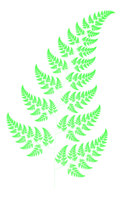
Approximate fractals are easily found in nature. These objects display self-similar structure over an extended, but finite, scale range. Examples include clouds, snow flakes, mountains, river networks, cauliflower or broccoli, and systems of blood vessels and pulmonary vessels.
Trees and ferns are fractal in nature and can be modeled on a computer by using a recursive algorithm. This recursive nature is obvious in these examples — a branch from a tree or a frond from a fern is a miniature replica of the whole: not identical, but similar in nature.
The surface of a mountain can be modeled on a computer by using a fractal: Start with a triangle in 3D space and connect the central points of each side by line segments, resulting in 4 triangles. The central points are then randomly moved up or down, within a defined range. The procedure is repeated, decreasing at each iteration the range by half. The recursive nature of the algorithm guarantees that the whole is statistically similar to each detail.
Fractal patterns have been found in the paintings of American artist Jackson Pollock. While Pollock's paintings appear to be composed of chaotic dripping and splattering, computer analysis has found fractal patterns in his work.[4]
-
A fractal is formed when pulling apart two glue-covered acrylic sheets.
-
High voltage breakdown within a 4″ block of acrylic creates a fractal Lichtenberg figure.
-
Fractal branching occurs on a microwave-irradiated DVD
-
Romanesco broccoli showing very fine natural fractals
-
A DLA cluster grown from a copper sulfate solution in an electrodeposition cell
Applications
As described above, random fractals can be used to describe many highly irregular real-world objects. Other applications [1] of fractals include:
- Classification of histopathology slides in medicine
- Generation of new music
- Generation of various art forms
- Signal and image compression
- Seismology
- Computer and video game design, especially computer graphics for organic environments and as part of procedural generation
- Fractography and fracture mechanics
- Fractal antennas — Small size antennas using fractal shapes
- Neo-hippies t-shirts and other fashion.
- Generation of patterns for camouflage, such as MARPAT.
- Digital sundial
See also
- Bifurcation theory
- Butterfly effect
- Chaos theory
- Complexity
- Constructal theory
- Diamond-square algorithm
- Feigenbaum function
- Fractal art
- Fractal compression
- Fractal landscape
- Graftal
- List of fractals by Hausdorff dimension
- Publications in fractal geometry
- Newton fractal
- Recursion
- Sacred geometry
- Turbulence
References
- ^ Mandelbrot, B. B. (1982). The Fractal Geometry of Nature. W. H. Freeman and Company. ISBN 0-7167-1186-9.
- ^ Falconer, Kenneth (2003). Fractal Geometry: Mathematical Foundations and Applications. John Wiley & Sons, Ltd. pp. xxv. ISBN 0-470-84862-6.
- ^ Eglash, Ron (1999). African Fractals. Rutger's University Press. ISBN 0-8135-2613-2.
- ^ Richard Taylor, Adam P. Micolich and David Jonas. Fractal Expressionism : Can Science Be Used To Further Our Understanding Of Art?
Further reading
- Barnsley, Michael F., and Hawley Rising. Fractals Everywhere. Boston: Academic Press Professional, 1993. ISBN 0-12-079061-0
- Falconer, Kenneth. Techniques in Fractal Geometry. John Willey and Sons, 1997. ISBN 0-471-92287-0
- Jürgens, Hartmut, Heins-Otto Peitgen, and Dietmar Saupe. Chaos and Fractals: New Frontiers of Science. New York: Springer-Verlag, 1992. ISBN 0-387-97903-4
- Benoît B. Mandelbrot The Fractal Geometry of Nature. New York: W. H. Freeman and Co., 1982. ISBN 0-7167-1186-9
- Peitgen, Heinz-Otto, and Dietmar Saupe, eds. The Science of Fractal Images. New York: Springer-Verlag, 1988. ISBN 0-387-96608-0
- Clifford A. Pickover, ed. Chaos and Fractals: A Computer Graphical Journey - A 10 Year Compilation of Advanced Research. Elsevier, 1998. ISBN 0-444-50002-2
- Jesse Jones, Fractals for the Macintosh, Waite Group Press, Corte Madera, CA, 1993. ISBN 1-878739-46-8.
- Hans Lauwerier, Fractals: Endlessly Repeated Geometrical Figures, Translated by Sophia Gill-Hoffstadt, Princeton University Press, Princeton NJ, 1991. ISBN 0-691-08551-X, cloth. ISBN 0-691-02445-6 paperback. "This book has been written for a wide audience..." Includes sample BASIC programs in an appendix.
- Sprott, Julien Clinton (2003). Chaos and Time-Series Analysis. Oxford University Press. ISBN 0-19-850839-5 and ISBN 978-0-19-850839-7.
- Bernt Wahl, Peter Van Roy, Michael Larsen, and Eric Kampman Exploring Fractals on the Macintosh, Addison Wesley, 1995. ISBN 0-201-62630-6
- Nigel Lesmoir-Gordon. "The Colours of Infinity: The Beauty, The Power and the Sense of Fractals." ISBN 1-904555-05-5 (The book comes with a related DVD of the Arthur C. Clarke documentary introduction to the fractal concept and the Mandelbrot set.
External links
- An introduction to fractals. An introductory course on fractals at Yale University.
- The Chaos Hypertextbook. An introductory primer on chaos and fractals.
- Fractal properties
- Fractal dimensions
- Natural fractals in Grand Canyon
- One Dimensional Dynamical Systems. From UIUC a brief introduction
- Rotational Fractal — Creation of simple fractals using arraying technique
- Spinning Fractal - Flash movie.
Multiplatform generator programs
- Xaos — free fractal real-time browser for Windows, Mac, Linux; supporting zooming and animation in real time, featuring autopilot. GNU GPL licensed.
- FLAM3 — free advanced iterated function system designer and renderer for all platforms. Windows binaries available. GNU GPL licensed.
- Fract — A web-based fractal zoomer, sending calculated images as bitmaps to the browser. Rather slow.
Linux generator programs
- XFractint — freeware fractal generator (ported from original DOS program), executable download available.
- Gnofract4d — Interactive editor which can use many fractint formulas. Open source, BSD-licensed.
- IFSgr — free iterated function system grayscale renderer. GNU GPL-licensed.
Windows generator programs
- Fractint — freeware fractal generator for DOS and Windows, with a port to Linux available.
- ChaosPro — freeware generator featuring real-time exploration, animation and more.
- Chaoscope — freeware 3D strange attractor rendering software for Windows.
- Fractal Explorer — freeware generator. Closed sourced, with source available for a fee.
- Fractal Extreme - freeware fractal generator allowing deep zooms and creation of zoom movies. (Purchased version zooms deeper.)
- Apophysis — freeware IFS fractal generator. GNU GPL licensed.
- Yet Another Fractal Explorer — freeware Lyapunov fractal renderer with zooming feature. GNU GPL licensed.
- Ktaza — freeware fractal renderer.
- Fractal Forge — freeware fractal generator capable of animations, but with low quality. GNU GPL licensed.
- Ultra Fractal — shareware fractal generator and graphic editor. Free trial version available.
- IFS Illusions - Freeware IFS generator
- MSPlotter — freeware fractal generator, using fractals to create bitmap images and AVI video clips.
- FRACTAL - Freeware. Analyser of holomorphics functions
Mac generator programs
- Altivec Fractal Carbon — benchmarking utility, using fractals to determine performance.
- IFSLab — a freeware iterated function system fractal generator for Mac OS X.
- Quadrium, Quadrium Flame — fractal/texture generation system and iterated function system fractal generator for Mac OS X respectively, both capable of creating movies.
Online generator programs
- Online fractal explorer — A fast web based mandelbrot explorer, fractals can be saved in a gallery.
- Wacker art fractal generator — Online fractal generaror with several different formulas.
Template:Link FA Template:Link FA Template:Link FA Template:Link FA Template:Link FA


